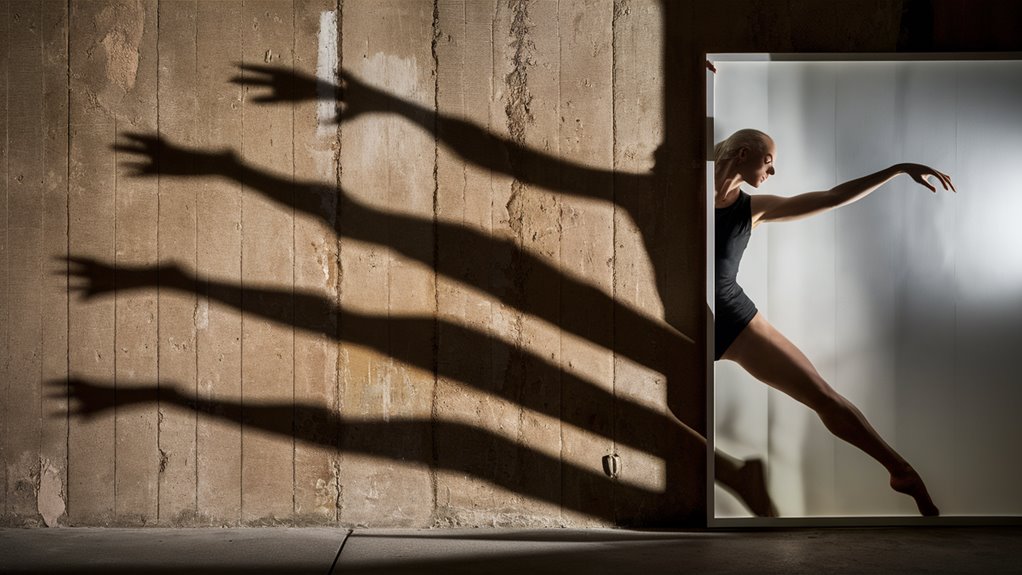The Art of Strategic Misdirection: Mastering Shadow Psychology
Shadow manipulation and intentional misdirection form the cornerstone of advanced psychological concealment. The intricate relationship between visual perception and cognitive processing creates powerful opportunities for strategic deception.
Understanding Shadow Psychology
The masterful use of silhouette dynamics involves carefully orchestrated movements that exploit natural human attention patterns. By leveraging cognitive blind spots and attentional bias, practitioners can effectively mask crucial behavioral indicators while maintaining seamless interaction.
Advanced Concealment Techniques
Military-grade concealment strategies draw from centuries of battlefield psychology, merging ancient wisdom with modern behavioral science. These tactical approaches create multiple layers of misdirection through:
- Visual pattern disruption
- Gestalt psychology principles
- Attention redistribution
- Behavioral masking
Frequently Asked Questions
Q: How does shadow psychology affect perception?
A: Shadow psychology influences perception by exploiting natural cognitive tendencies to process visual information in predictable patterns.
Q: What role does movement play in misdirection?
A: Strategic movement creates attention focal points that naturally draw observer focus away from critical behavioral tells.
Q: Can silhouette manipulation be detected?
A: Expert silhouette manipulation remains virtually undetectable when properly executed using established psychological principles.
Q: How do cognitive blind spots enable concealment?
A: Natural cognitive blind spots provide opportunities to mask crucial information within areas of reduced attention processing.
Q: What distinguishes effective from ineffective misdirection?
A: Effective misdirection seamlessly integrates with natural behavior patterns while maintaining psychological plausibility.
The Psychology of Visual Deception

The Psychology of Visual Deception in Magic
Understanding Attention Manipulation
Visual misdirection operates through precise manipulation of the audience’s attention. Professional magicians utilize carefully choreographed movements to guide spectators’ focus while executing their methods in psychological blind spots.
Each deliberate gesture serves dual purposes – creating compelling misdirection while concealing crucial actions.
The Neuroscience Behind Magic
The human brain’s cognitive limitations make it susceptible to calculated deception. When presented with a dominant visual stimulus, neural resources automatically redirect, creating temporary attention blindness to secondary movements.
This isn’t about speed – it’s about leveraging the brain’s natural processing patterns and perceptual tendencies.
Advanced Psychological Techniques
Perceptual psychology principles reveal how magicians exploit the brain’s motion processing. By incorporating smooth, continuous movements while hiding technical actions within naturally filtered saccadic movements, performers create perfect conditions for visual deception.
These techniques stem from deep understanding of cognitive psychology and attention mechanisms.
Frequently Asked Questions
Q: How do magicians direct attention so effectively?
A: Through studied application of psychological principles and precise movement choreography targeting natural attention patterns.
Q: What role does neuroscience play in magic?
A: Understanding brain processing limitations enables magicians to exploit cognitive blind spots and attention filters.
Q: Why can’t we detect misdirection even when we know it’s happening?
A: Our brains are hardwired to process dominant visual stimuli, making secondary movements nearly invisible.
Q: How important is timing in visual deception?
A: Timing is crucial – actions must align perfectly with attention shifts and natural cognitive processing patterns.
Q: What makes professional misdirection different from simple distraction?
A: Professional misdirection employs sophisticated psychological principles and detailed understanding of perceptual processing.
Military Applications Through History
Military Deception Through History: Strategic Applications and Evolution
Ancient Foundations of Military Deception
Military deception has shaped warfare since ancient times, with strategic misdirection serving as a cornerstone of battlefield success.
Sun Tzu’s principles established fundamental concepts of appearing weak when strong and strong when weak, creating a framework that military commanders still follow today.
Classical Warfare and Psychological Operations
The Trojan Horse represents history’s most iconic military deception, establishing a blueprint for psychological warfare.
Hannibal’s tactical prowess demonstrated through calculated campfire placement and strategic misdirection proved instrumental in outmaneuvering Roman forces, showcasing how deception could multiply military effectiveness.
Modern Military Deception Tactics
World War II marked a watershed in military deception evolution, particularly through Operation Fortitude. This comprehensive deception plan protected D-Day operations through:
- Inflatable tanks and equipment
- False radio transmissions
- 먹튀검증
- Double agents feeding misinformation
- Elaborate staging of non-existent army groups
Digital Age Warfare and Deception
Contemporary military planners adapt historical deception principles to modern technological environments.
Digital warfare includes:
- Cyber deception operations
- Electronic warfare capabilities
- Information warfare tactics
- Network-centric battlefield deception
Frequently Asked Questions
Q: What’s military deception?
A: Military deception involves actions to deliberately mislead enemy forces about military capabilities, intentions, and operations.
Q: How did Sun Tzu influence military deception?
A: Sun Tzu established core principles of strategic deception that emphasize appearing weak when strong and manipulating enemy perceptions.
Q: What role did deception play in World War II?
A: Deception was crucial in WWII, particularly in Operation Fortitude, which protected D-Day through elaborate misleading operations.
Q: How has military deception evolved in modern warfare?
A: Modern military deception incorporates digital elements, cyber operations, and electronic warfare while building on historical principles.
Q: What makes military deception effective?
A: Effective military deception exploits enemy biases and existing beliefs, making adversaries active participants in their own misleading.
Movement and Shadow Manipulation

Mastering Shadow and Movement Manipulation: Advanced Techniques
Understanding Shadow Dynamics
Shadow manipulation requires deep understanding of how light interacts with movement.
Distinctive shadows cast by subtle movements can reveal positions to observant eyes, making shadow control essential for stealth operations and tactical advantage.
Strategic Movement Techniques
Advanced movement patterns create calculated interplays of light and dark.
By controlling weight distribution and body positioning, practitioners can direct attention through strategic shadow placement.
This mastery transforms potential vulnerabilities into powerful tools for tactical deception.
Multi-Source Shadow Manipulation
Shadow fragmentation techniques utilize multiple light sources to break continuous silhouettes.
Understanding how to position against ambient light creates complex shadow patterns that confuse observers and enhance concealment capabilities.
Frequently Asked Questions
Q: How do shadows affect movement detection?
A: Shadows serve as visual indicators of position and movement, making them crucial for detection and concealment.
Q: What’s shadow fragmentation?
A: Shadow fragmentation involves breaking up continuous shadow patterns using multiple light sources to create visual confusion.
Q: How does weight distribution affect shadow manipulation?
A: Strategic weight shifts alter shadow patterns, enabling controlled direction of observer attention.
Q: Can multiple light sources enhance concealment?
A: Yes, utilizing multiple light sources creates complex shadow patterns that increase concealment effectiveness.
Q: What role does misdirection play in shadow manipulation?
A: Misdirection techniques use calculated movements to create deceptive shadow patterns, directing attention away from actual position.
Advanced Shadow Control
Mastering silhouette manipulation requires understanding human perception patterns.
Implementing tactical misdirection through controlled movements while maintaining awareness of light source positioning enables superior concealment and deception capabilities.
Cultural Impact of Strategic Misdirection
The Cultural Evolution of Strategic Misdirection
Ancient Origins to Modern Applications
Strategic misdirection has transformed from ancient ceremonial practices into a sophisticated cultural phenomenon.
Traditional civilizations employed ritualistic deception through elaborate ceremonies, while contemporary society has developed this art into refined methodologies across multiple domains.
Digital Age Transformation
Modern entertainment platforms have revolutionized misdirection techniques through:
- Psychological thrillers
- Stage illusions
- Digital media manipulation
- Virtual reality experiences
Business and Social Impact
Strategic misdirection has become integral to:
- Corporate negotiations
- Marketing strategies
- Political communications
- Social media management
Digital Adaptation and Evolution
The emergence of digital platforms has created new venues for strategic misdirection, transforming traditional techniques into:
- Content curation
- Personal branding
- Online presence management
- Digital narrative control
Frequently Asked Questions
Q: How has strategic misdirection evolved in the digital age?
A: Modern technology has transformed misdirection into sophisticated digital techniques used across social media, marketing, and entertainment platforms.
Q: What role does misdirection play in business strategy?
A: Strategic misdirection serves as a crucial tool in negotiations, marketing campaigns, and competitive positioning.
Q: How does social media utilize misdirection techniques?
A: Social platforms employ strategic content timing, selective information sharing, and calculated persona management.
Q: What impact does misdirection have on modern entertainment?
A: Contemporary entertainment incorporates misdirection through complex narratives, visual effects, and interactive experiences.
Q: Are digital misdirection techniques more effective than traditional methods?
A: Digital techniques offer broader reach and more sophisticated implementation, though traditional principles remain fundamental to successful misdirection.
Mastering the Art of Tells

Mastering the Art of Reading Body Language Tells
Understanding Nonverbal Communication Cues
Body language analysis remains one of the most powerful tools in human communication.
The mastery of reading tells combines scientific observation with refined intuition, offering invaluable insights into human behavior and hidden thoughts.
Detecting Subtle Physical Indicators
Microexpressions and unconscious gestures serve as windows into genuine emotional states. The most revealing tells manifest through:
- Facial muscle movements
- Autonomic responses
- Gestural inconsistencies
- Timing discrepancies
Advanced Tell Recognition Techniques
Behavioral pattern analysis requires focusing on the complete spectrum of nonverbal signals.
Expert observers recognize that authentic body language tells emerge through:
- Natural movement clusters
- Baseline behavior deviations
- Contextual gesture analysis
FAQ: Common Questions About Reading Tells
Q: What’re the most reliable body language tells?
A: The most dependable tells involve clusters of unconscious behaviors rather than isolated gestures.
Q: How can someone improve their ability to read tells?
A: Practice observing baseline behaviors and noting deviations in controlled environments.
Q: Are some people naturally better at reading tells?
A: While natural aptitude varies, systematic training can significantly enhance anyone’s observation skills.
Q: Can tells be effectively concealed?
A: Conscious suppression of tells is challenging due to their unconscious nature.
Q: How long does it take to master reading tells?
A: Developing professional-level expertise typically requires years of dedicated practice and study.
